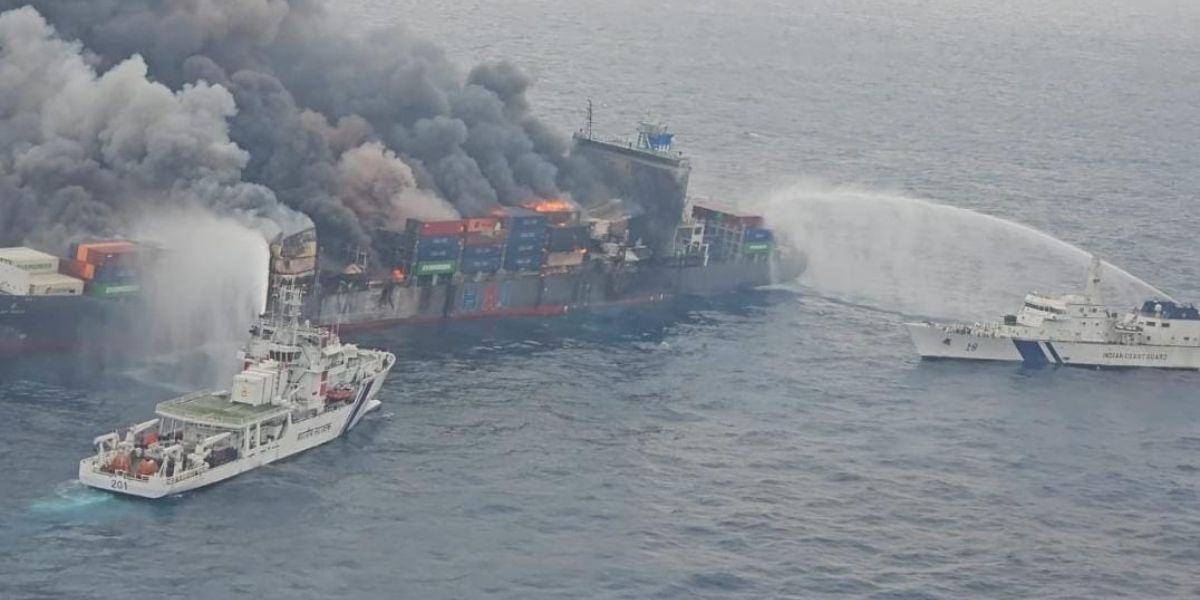Experts warn that the release of toxic substances — whether through fire, explosion, or containers falling into the sea — could have severe environmental repercussions.
Published Jun 10, 2025 | 3:33 PM ⚊ Updated Jun 23, 2025 | 9:16 AM

MV Wan Hai 503 on fire.
Synopsis: Within two weeks, two shipwrecks occurred off the Kerala coast, highlighting the need to address the country’s maritime risk preparedness. With Kerala’s fisheries sector integral to its economy and high fish consumption culture, the crisis threatens to ripple through the state’s economy, ecology and public health.
As the dangerous goods manifest of MV Wan Hai 503, which caught fire 78 nautical miles off the Kerala coast, continues to be released for the second day on Tuesday, 10 June, the nation finds itself staring at the unfolding of an unprecedented maritime crisis.
The immediate fallout — and perhaps the heaviest burden — is poised to fall on Kerala, a state where the sea is both a livelihood and a lifeline.
With Kerala’s fisheries sector integral to its economy and high fish consumption culture, the crisis threatens to ripple through the state’s economy, ecology and public health.
The alarm bells first rang with the sinking of MSC ELSA 3 on 25 May, barely two weeks before the MV Wan Hai incident. And while the dangerous goods manifest of MSC ELSA 3 remains officially unreleased, what little has surfaced paints a grim, unsettling picture.
What’s slowly unravelling is not just a maritime mishap, but a potential environmental and economic disaster inching closer to Kerala’s shores.
MV Wan Hai 503 battles persistent fires and explosions aboard, with grave environmental concerns looming.
The Indian Coast Guard has reported that the vessel, listing approximately 10–15° to port, continues to burn from mid-ships to the container bay ahead of the accommodation block.
Several containers have already toppled overboard, raising fears of hazardous materials spilling into the sea.
What makes the situation particularly alarming is the ship’s Dangerous Goods Manifest — a document listing 157 entries of hazardous cargo currently at risk.
Among the contents are highly flammable substances such as resin solution and nitrocellulose with alcohol, along with a range of environmentally hazardous materials, including diacetone alcohol, ammonium metavanadate, piperazine, bipyridilum pesticides, phosphoric acid solution, crude naphthalene, printing ink, and dichloromethane.
Experts warn that the release of these substances — whether through fire, explosion, or containers falling into the sea — could have severe environmental repercussions.
Chemicals like dichloromethane are toxic to marine life, while pesticides and phosphoric acid can disrupt aquatic ecosystems and harm fish stocks.
Naphthalene and crude oil derivatives, if leaked, can form slicks, affecting seabirds and marine mammals.
Additionally, the burning of such chemicals releases hazardous fumes, posing a serious health risk to the crew, rescuers, and nearby coastal communities, depending on wind direction and intensity.
Efforts are underway to contain the blaze and stabilise the vessel, but with volatile cargo and worsening conditions, maritime authorities and environmental agencies remain on high alert.
The Indian Coast Guard has intensified its monitoring.
In the case of MSC ELSA 3, as per unofficial reports, among the dangerous goods onboard were calcium carbide, quick lime, slaked lime, hydraulic lime, hydrazine, polyethene, polymers, and bleached chemi-thermo mechanical pulp — substances known to pose serious environmental and public health risks if released into marine ecosystems.
The vessel was carrying 643 containers when it ran into trouble.
By 9 June, a total of 64 containers had been beached across various districts — with Kollam witnessing the highest count at 49, followed by Thiruvananthapuram (13) and Alappuzha (two).
Additionally, 21 barrels have also drifted ashore, sparking concerns among coastal communities and fisherfolk.
Environmental experts warn that exposure to chemicals like hydrazine and calcium carbide can severely contaminate seawater, endanger marine life, and disrupt fishing activities.
Quick lime and hydraulic lime, when in contact with water, can release heat and alter water pH levels, threatening fragile aquatic ecosystems.
Authorities have intensified surveillance along the coast and issued advisories to avoid handling unidentified containers and barrels.
The other common danger that these marine incidents pose is the risk of an oil spill.
It is being pointed out that ships carry significant amounts of fuel (diesel, furnace oil, marine gas oil), and sinking can lead to an oil spill, which spreads rapidly, forming a layer on the water surface.
This layer blocks sunlight, disrupting photosynthesis in marine plants and phytoplankton (crucial for oxygen production and the base of food chains). It also poses risks to seabirds and coastal birds.
A study published in the Journal of Cleaner Production in 2022, titled ‘Emerging marine pollution from container ship accidents: Risk characteristics, response strategies, and regulation advancements’, states that container ship accidents can contaminate the surrounding marine environment and even have a wider impact.
It further added, the contamination derived from heavy metals, plastic fibre, leaked fuel, and hazardous and noxious substances after accidents can endanger entire marine habitats and be continuously accumulated through the food chain, eventually posing a threat to human health.
The risks and pollution caused by container boxes are often overlooked.
(Edited by Muhammed Fazil.)
